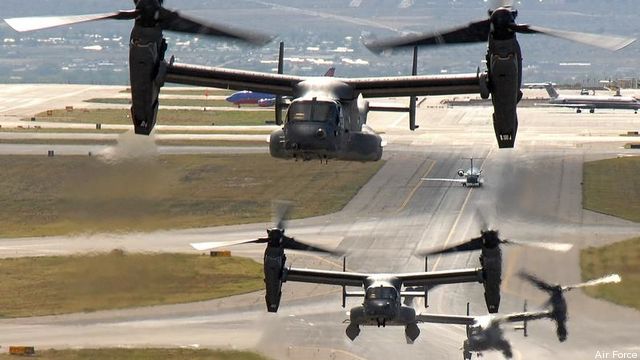The Next Phase for the V-22 Osprey: Build Global Support Like C-17
Posted on
The V-22 Osprey will reach the eight-year mark in its operational deployment history this September. The Osprey-enabled assault force is redefining ways to think about the insertion and withdrawal of force and new ways to engage, prevail and disengage.
The program has reached a critical turning point – can the Osprey be purchased by allies, and be effectively supported worldwide? Can that allied opportunity be merged with an enhanced capacity to support forward deployed Ospreys, flown by the Marines, the Air Force and, soon, the Navy for its carrier support operations?
A number of allies beyond Japan and Israel are interested in buying the plane. But to get to this new phase, challenges need to be met and resolved to clear the path. The plane was never built as a global product, nor was it designed for global sourcing or for wide-ranging, high demand global support.
Put bluntly, the current system of support falls short of meeting that growing demand signal. In interviews I have done over the past few years with Osprey maintainers and operators, it is clear that there is a concern with supply shortfalls and uncertainties unduly affecting operational demands because the demand signal is higher than DoD decision makers expected.
“As a growing number of unprecedented new missions and operating locations are added to the V-22 community’s repertoire, and new international and domestic customers seek to obtain the Osprey, we must ensure the global supply chain evolves to keep pace with this incredible revolution in military technology,” as former Marine deputy Commandant for aviation, retired Lt. Gen. George Trautman, put it.
Clearly, a global sourcing system is possible. Boeing need look no further than its own very successful C-17 global sustainment program. The C-17 has parts sharing and support by the company worldwide. This sustainment program has allowed allies to buy the airplane and to work completely interactively with the US Air Force.
Clearly, such an approach needs to be shaped to enable the global opportunity of the Osprey to unfold. It would be a significant failure if this does not happen simply by failing to meet the strategic shift, which a new approach to Osprey sustainment requires.
The recently announced sale of Ospreys to Japan provides an opportunity to put in motion a more global approach. Ospreys operating from Japan and by Japan will operate from a high demand and high stress-operating environment. CV-22s, MV-22s and Japanese V-22s can all be sourced from a common warehouse with a higher than adequate supply part sourcing.
Because demand is flexible and the American Ospreys operate throughout the region, ramping up parts stores in a regional warehouse would make sense and could start the process of globalization of the Osprey.
The demand signal will go up driven by the new capabilities associated with the Osprey itself. One demand will arise from the mission of supporting F-35Bs at sea. During the USS Wasp sea trials in May, the Osprey demonstrated that it could deliver the F-35B engine to the USS Wasp. Allies who fly the F-35B will also be looking for the Osprey to support the Joint Strike Fighter’s shipboard operations.
This capability was not something the military asked for. Industry invested its own money in an effort to shape a possible way ahead. “Pratt and Whitney started the process and started to look at the capability of utilizing the V-22 to get the loaf of bread — the engine inside the breadbox, so to speak.” Michael Chotkowski, the lead for ship integration of the F-35 engine with Pratt and Whitney, said.
The Marines did fly an Osprey to Pratt’s Connecticut facilities during the evaluation process, so the P&W engineers could have accurate measurements and discuss operations with loadmasters and aircrew to craft a realistic solution. On o the key issues was how to loading and unload the engine module through the door.
Navy assistant secretary for research, development and acquisition Sean Stackley pushed hard for a solution set for the power module resupply problem. Industry designed the concept skid which took more than eight months. The next step was for the Marine Corps, working with the Joint Program Office, to build the rapid prototype skid seen aboard the Wasp.
The Osprey is evolving a broader range of multi-mission capabilities as well which will enhance the demand for Ospreys such as the aerial refueling piece. The Marines clearly want to add aerial refueling to the Osprey fleet to work with the F-35Bs and Harriers aboard large deck amphibious ships.
It also opens up possibilities of change for the large deck carrier community as well. The capability is important, but equally interesting is the approach Bell-Boeing has developed to prepare for the possible introduction of air refueling.
During a visit to Boeing’s Osprey factory in Philadelphia, Boeing laid out their approach for the development of the refueling capability. Basically, Boeing uses its 3-D Virtual Reality simulation facility to develop requirements for the onboard aerial refueling system.
This means that requirements help the preliminary and detailed design phases. Continuous use of the lab throughout the remaining engineering development tasks supports “in-process” evaluation of prototypes. Instead of taking years, it takes months to get an initial design right.
It is crucial to improve the ability of the Marines, Navy and international partners ability to globally sustain the V-22 to ensure a smooth and successful transition to the next phase of Osprey global operations.
Subscribe to our newsletter
Promotions, new products and sales. Directly to your inbox.

